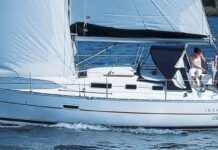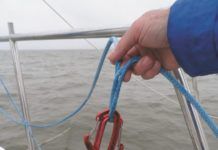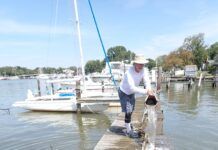
Getting rid of the big genoa is usually easy thanks to roller furling, but what do you do then? Changing sails on the furling unit is a daunting task when short-handed, and sailboats don’t power particularly well in a big sea.Heres an easy, safe, and seamanlike solution: Set your boat up with an inner forestay, and when these conditions arise, roll your big genoa up, set your forestaysail, and away you go.
This is easy and safe because sailing under the mainsail alone slows your boat and reduces heel, so working forward of the mast is not such a chore. Also, since youre working in the middle of the foredeck and not up at the stem, theres much less chance of you or the sail going overboard.
The inner forestay is typically attached to the mast at the upper spreader and lives next to the mast when not in use. It is made fast to its deck fitting and can be tensioned in a variety of ways. Once this is done, the forestaysail can be hanked on, the halyard and sheets attached, and all thats left is to hoist and trim the sail.
All of these steps can be accomplished quite easily by one person. The sail is relatively small and light, so it can be handled without difficulty. Once hanked on, it is completely under control. The boat itself will now sail comfortably, and you will be pleasantly surprised at how well it does with this rig. Although you will feel underpowered, your speedometer will attest to the setups efficiency. On most points of sail, youll find yourself going 75 to 80 percent of your maximum speed.
The benefits don’t end there. On reaching passages, the forestaysail can be set inside your genoa and can add a quarter- to a half-knot. In storm conditions, you can lower and secure the forestaysail and set the storm jib on the inner forestay. The combination of forestay and runners (the use of runners to oppose the inner forestay is recommended, particularly offshore) greatly increases the stability of your mast.
PS has explored inner-forestay retrofits from various angles in the past, and our testers have evaluated the hardware required for an upgrade. For links to these articles, professional tips, and examples of retrofits on other cruising boats, see the DIY Solent Stay or Inner Forestay.



































